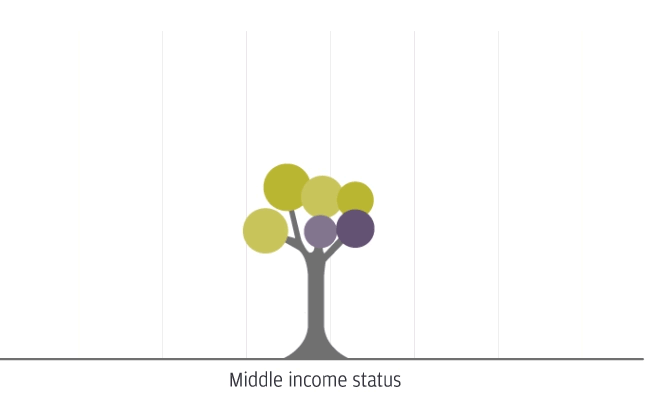China's path to becoming a higher income country
05-11-2019
Michael Hood
Patrik Schowitz
The next phase of China’s growth
Key points
- China stands at the cusp of middle income status. Over the next 10 to 15 years, despite the challenges, we project a 4.4% annual rise in real GDP should bring it to high income status—avoiding the “middle income trap”—as South Korea and Taiwan also did.
- While China’s equity and bond markets are the world’s second largest, the investment opportunity set does not match China’s economic heft, and changes to its financial markets likely lie ahead—posing opportunities and risks for investors.
- Investors able to carry out the requisite analysis may find opportunities, including in China’s rising services (including financial services) and consumer sectors, and elsewhere in Asia as China’s development effects reach beyond its borders.
China will likely reach a milestone in its development in 2019: achieving USD 10,000 GDP per capita. This massive improvement in the living standards of more than a billion people is one of history’s greatest economic success stories. However, China’s growth has already slowed and very few developing economies, after hitting the 10K per capita mark, have maintained strong growth momentum but rather have fallen into the well-known, pervasive “middle income trap.”
Will China escape the trap, continue growing rapidly past 10K per capita and converge toward the world’s richest economies? We believe it will. This would constitute a remarkable, unusual success story, especially given a somewhat unforgiving international climate and, unlike two other success stories, South Korea and Taiwan, China faces weaker demographics and an overreliance on an inefficient state sector.
Our base-case GDP growth expectation for China is an average of 4.4% over 10 to 15 years, leading to high-income status (by the World Bank’s definition) by 2034. Successful pursuit of economic reforms could steer China onto a somewhat faster growth trajectory; downside risk comes primarily from elevated leverage.
While China’s economy and capital markets should face challenges as they evolve, investors able to carry out the requisite analysis may find opportunities as China seeks to maintain rapid growth. Key risks and opportunities in the post-10K phase include:
For the economy:
- Trade terms are uncertain, and global trade volumes and prices are not growing, as they were when Korea and Taiwan were at this stage.
- China’s shrinking working-age population demographics are appreciably worse than Korea’s and Taiwan’s at the 10K mark, though urbanization (China remains relatively rural) should provide some offset.
- Bank credit to favored sectors and enterprises in China is a problem, as the authorities acknowledge—because rapid debt accumulation is associated with elevated likelihood of financial crisis.
- China’s large state-owned enterprises (SOEs) are inefficient, however growth could be improved by structural reform of SOEs, which is a government priority.
For asset markets and investors:
- China’s policy emphasis on market-driven pricing will likely support bond market growth, while the shifting of risk from banks to markets should help improve the bond market’s liquidity.
- China’s inclusion in benchmark bond and stock indices has spurred large inflows of foreign investment, yet foreign ownership remains low by international standards, suggesting room to grow.
- The rise of Chinese institutional investors should help stabilize equity market volatility.
- The services- and consumer-focused equity sectors will likely offer investment opportunities but at the expense of the energy, materials and industrial sectors, which does not bode well for industrial firms in Hong Kong, Taiwan, Korea and Singapore.
- More open access to China’s large financial sector should benefit Hong Kong and Singapore financial firms.
Investors able to carry out the requisite analysis may find opportunities in China’s equity and bond markets, the world’s second largest, and elsewhere in Asia as China’s economy develops beyond the 10K milestone.
You should also read
Assumption matrices
Arranged in an easy-to-reference format, each LTCMA matrix provides our expectations for returns, volatilities and correlations.
Full report and executive summary
Choose between a comprehensive analysis of our forecasts and critical investment themes, or a simpler overview of our macro and asset class assumptions.
Download the executive summary >
The future impact of e-commerce on the economy
Discover what the adoption of e-commerce technology can mean for economic growth and investment opportunities. Read the insights from our 2020 LTCMA.
0903c02a82743f43
